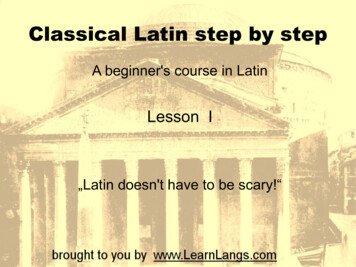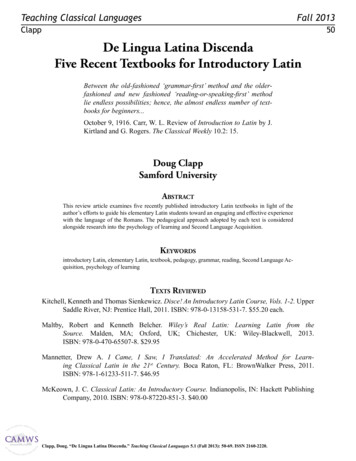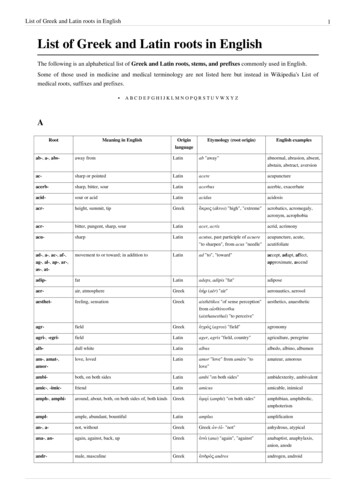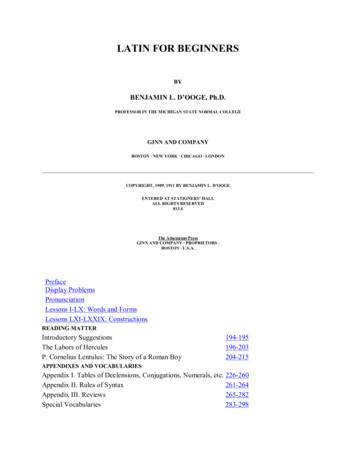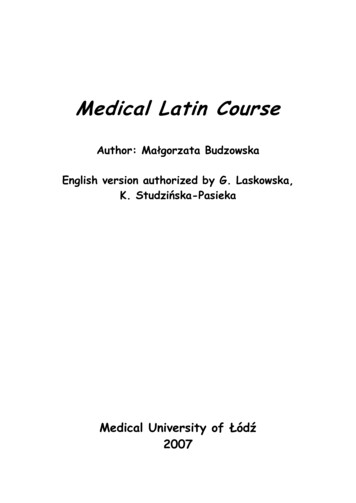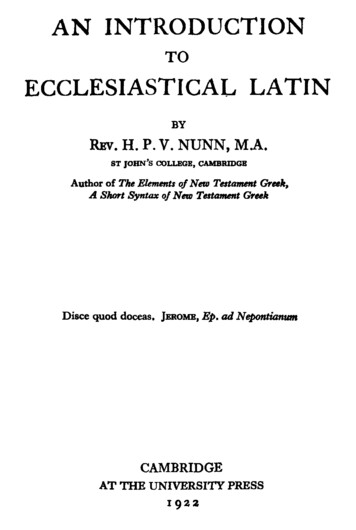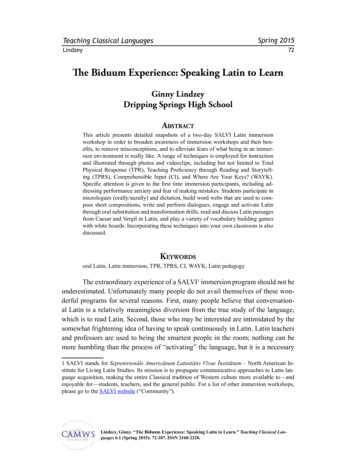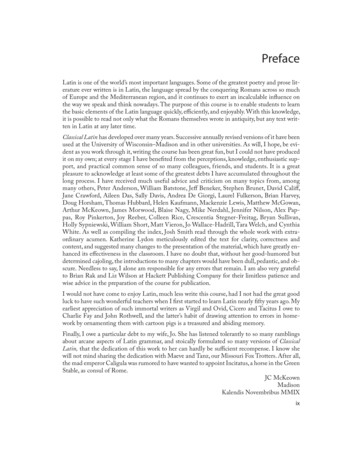
Transcription
00McKeown front:Classical Latin1/16/1012:13 PMPage ixPrefaceLatin is one of the world’s most important languages. Some of the greatest poetry and prose literature ever written is in Latin, the language spread by the conquering Romans across so muchof Europe and the Mediterranean region, and it continues to exert an incalculable influence onthe way we speak and think nowadays. The purpose of this course is to enable students to learnthe basic elements of the Latin language quickly, efficiently, and enjoyably. With this knowledge,it is possible to read not only what the Romans themselves wrote in antiquity, but any text written in Latin at any later time.Classical Latin has developed over many years. Successive annually revised versions of it have beenused at the University of Wisconsin–Madison and in other universities. As will, I hope, be evident as you work through it, writing the course has been great fun, but I could not have producedit on my own; at every stage I have benefited from the perceptions, knowledge, enthusiastic support, and practical common sense of so many colleagues, friends, and students. It is a greatpleasure to acknowledge at least some of the greatest debts I have accumulated throughout thelong process. I have received much useful advice and criticism on many topics from, amongmany others, Peter Anderson, William Batstone, Jeff Beneker, Stephen Brunet, David Califf,Jane Crawford, Aileen Das, Sally Davis, Andrea De Giorgi, Laurel Fulkerson, Brian Harvey,Doug Horsham, Thomas Hubbard, Helen Kaufmann, Mackenzie Lewis, Matthew McGowan,Arthur McKeown, James Morwood, Blaise Nagy, Mike Nerdahl, Jennifer Nilson, Alex Pappas, Roy Pinkerton, Joy Reeber, Colleen Rice, Crescentia Stegner-Freitag, Bryan Sullivan,Holly Sypniewski, William Short, Matt Vieron, Jo Wallace-Hadrill, Tara Welch, and CynthiaWhite. As well as compiling the index, Josh Smith read through the whole work with extraordinary acumen. Katherine Lydon meticulously edited the text for clarity, correctness andcontent, and suggested many changes to the presentation of the material, which have greatly enhanced its effectiveness in the classroom. I have no doubt that, without her good-humored butdetermined cajoling, the introductions to many chapters would have been dull, pedantic, and obscure. Needless to say, I alone am responsible for any errors that remain. I am also very gratefulto Brian Rak and Liz Wilson at Hackett Publishing Company for their limitless patience andwise advice in the preparation of the course for publication.I would not have come to enjoy Latin, much less write this course, had I not had the great goodluck to have such wonderful teachers when I first started to learn Latin nearly fifty years ago. Myearliest appreciation of such immortal writers as Virgil and Ovid, Cicero and Tacitus I owe toCharlie Fay and John Rothwell, and the latter’s habit of drawing attention to errors in homework by ornamenting them with cartoon pigs is a treasured and abiding memory.Finally, I owe a particular debt to my wife, Jo. She has listened tolerantly to so many ramblingsabout arcane aspects of Latin grammar, and stoically formulated so many versions of ClassicalLatin, that the dedication of this work to her can hardly be sufficient recompense. I know shewill not mind sharing the dedication with Maeve and Tanz, our Missouri Fox Trotters. After all,the mad emperor Caligula was rumored to have wanted to appoint Incitatus, a horse in the GreenStable, as consul of Rome.JC McKeownMadisonKalendis Novembribus MMIXix
00McKeown front:Classical Latin1/20/101:16 PMPage xiAbbreviationsabl.abl. blativeablative absoluteaccusativeactiveannō dominī (in the year of our Lord)adjectiveadverbbefore Christcircā ationconfer (compare)dativedeclensiondeponentexemplī grātiā (for example)Englishet cētera (and the other d est (that . lPseudoruledreflexiverelativesub verbō (see ivevocativexi
00McKeown front:Classical Latin1/16/1012:13 PMPage xiiiHow to Use Classical LatinClassical Latin, a textbook for use in a year-long college course or a single intensive semester,makes learning Latin practical and interesting for today’s student. In each chapter, you will Master new grammar using a set of vocabulary words that you already know (poets,pirates, and, above all, pigs). Since these words recur in every chapter, they allow you tofocus on the unfamiliar grammar until you have understood how the new structures work. Go on to practice the structures you have just learned using new words, constantly enlarging your vocabulary and preparing to read real Latin. This section is called Prōlūsiōnēs,after the practice fights with which gladiators warmed up for their battles in the arena. Read passages by ancient Roman prose authors that use words and grammar you know,and answer simple comprehension questions about them. This will allow you to readLatin for the content and the author’s ideas without worrying about a precise translation.You can start getting a feel for what the Romans said, as well as how they said it. Thissection is called Lege, Intellege, “Read and Understand.” Read passages of Roman poetry that use the grammar and vocabulary you have learnedin the chapter and be able to explain how the structures work. Even when Virgil and Oviduse it, the grammar works the same way. This section is called Ars Poētica, “The PoeticArt.” See the chapter’s grammar and vocabulary used by great Roman authors in “Golden Sayings” or Aurea Dicta. Explore how Latin has contributed to English (Thēsaurus Verbōrum, “A Treasure Store ofWords”) and how the Romans thought about their own language (Etymologiae Antīquae). Learn something about the people who spoke the language you are learning. This section, Vīta Rōmānōrum (“The Life of the Romans”), gives you a passage translated from aClassical Latin text, illustrating some aspect of Roman history, social life, culture, or religious beliefs.The grammar explanations and paradigms and the activities using readings (Lectiōnēs Latīnae)are the core of each chapter. The Thēsaurus Verbōrum and Etymologiae Antīquae sections (startingin Chapter 11), as well as the Vīta Rōmānōrum passages, are optional extra material, or as the Romans would have said, Lūsūs (“Games”).In addition, the “Vocabulary Notes” give you further information about how to use the words ineach vocabulary list, while occasional sections entitled Notā Bene, or “notice well,” draw your attention to unusual or easy-to-miss aspects of the material.xiii
00McKeown front:Classical Latin1/16/1012:13 PMPage xvIntroductionWhat Is Classical Latin?The term “Latin” refers to the language used in Latium, the western central region of Italy, whichwas dominated by the Romans from the early years of the first millennium BC. Through centuries of warfare, followed by military occupation and integration with native populations, theRomans spread the Latin language over a vast empire that embraced the whole Mediterraneanbasin and stretched north to southern Scotland and east almost as far as the Caspian Sea.Classical Latin is the written language of the period roughly 80 BC to 120 AD, two centuriesthat saw the collapse of the Roman Republic and the establishment of the imperial system ofgovernment and also produced most of Rome’s greatest literary achievements.Given that the Roman empire was so vast and endured so long, one might expect that Latinwould vary from one region of the empire to another and change over time (as American English differs from British English, and Elizabethan English from modern English). Here we haveto distinguish between spoken Latin and written Latin. Such variations and developments were,in fact, always a feature of the spoken language: regional versions of spoken Latin would laterevolve into the Romance languages—Italian, Spanish, Portuguese, French, and so on in the west,Romanian in the east. This evolution took place very gradually, as Latin replaced other languagesin various parts of the empire. In strong contrast to spoken Latin, however, the written languagewas never much influenced by the different dialects and was very resistant to change for severalreasons.Roman rule was firmly centralized in Rome itself, which was also the cultural heart of the empire. Not surprisingly, therefore, standards for the correct use of Latin were set by Rome. Eventhough the majority of the great Roman writers came originally from distant parts of Italy andfrom the provinces, they conformed to these standards, so that their writing hardly ever includedlocalized idioms and vocabulary that they might have used in speaking.A further reason why written Latin is so standardized is that the great age of Roman literaturewas very brief, and it is this period that produced the texts that constitute and define ClassicalLatin. For more than half a millennium after its founding, Rome was essentially a military state,struggling for survival and expansion. Such a society was not congenial to literary and culturalcreativity. Then the second century BC brought Rome greater security through the subjugationof Carthage, the only rival power in the western Mediterranean. It also brought wider intellectual horizons through contact with Greece. The way was therefore open for the flowering of Roman culture over the next two centuries.Throughout Europe until recent times, the education system was extremely conservative. A veryfew great prose writers and poets, Cicero and Virgil above all, were adopted as models of Latinity, and the language was codified, restricted, and then transmitted century after century in accordance with these models. Depending on one’s point of view, this conservatism either ensuredxv
00McKeown front:Classical Latin1/16/1012:13 PMPage xviIntroductionthe purity of Classical Latin or prevented the written language from evolving. As spoken Latingradually dropped out of use or was transformed into the Romance languages, those who continued to write in Latin still wanted to imitate the great authors of the classical period. Thismeans that once you know Classical Latin you will have the basis for reading texts written at anytime from pagan antiquity through to the Renaissance and more modern periods.The Cultural ContextThe influence of the Romans on the modern world is hard to overstate. Without them, our language, our literature, the way we think would have been very different. That said, however, it isimportant to realize that Roman society was quite alien to ours. Women had almost no role inpublic life and were generally under the legal control of their fathers, husbands, or brothers. Theeconomy depended on slavery: at the end of the first century BC, perhaps as much as one-thirdof the population of Italy were slaves. All classes of society enjoyed the bloody spectacle of gladiatorial contests, which were first introduced in the third century BC as a form of human sacrifice in honor of the dead: in AD 107, at the games celebrating his subjugation of the lowerDanube, the emperor Trajan had five thousand pairs of gladiators fight each other. Accounts ofthe empire’s expansion, since they were written by the Romans themselves, naturally tended toglorify their military exploits: Julius Caesar’s conquest of Gaul is an extraordinary achievement,but it was based on what we would probably call genocide, with perhaps more than a millionpeople being exterminated in less than a decade.For these reasons we may not always sympathize with the Romans, but it would be difficult notto respect their accomplishments. In order to provide some insight into Roman culture, this bookuses, as much as possible, Latin texts written by Roman authors themselves.You Already Know More Latin Than You Think:Using English to Master Latin VocabularyEnglish belongs to the Germanic branch of the vast Indo-European family of languages, whereasLatin belongs to the quite separate Italic branch. These two branches lost contact with each otherseveral millennia ago in the great migration westward from the Indo-European homeland. English derives its basic grammatical structure and almost all of its most commonly used words fromits Germanic background. Nevertheless, Latin came to have a dominant influence on English,vastly increasing its vocabulary, after the Normans conquered the British Isles in 1066. Latin wasthe language of both the church and the legal system, and French, a Romance language deriveddirectly from Latin, was the Normans’ mother tongue. It is estimated that well over 60 percentof nontechnical modern English vocabulary is Latinate.To appreciate the extent of the influence of Latin on English vocabulary, study the followingparagraph of German for a few minutes. How many of the words are familiar enough for you toguess their meaning?xvi
00McKeown front:Classical Latin1/16/1012:13 PMPage xviiIntroductionNilpferde sind grosse, dicke Tiere, die in Afrika im Nil leben. Zahlreiche afrikanischeTiere sind furchterregend und sehr wild, nämlich Krokodile, Löwen, Leoparden,Nashörner, Hyänen, Skorpione, Aasgeier, Schlangen (z.B. Riesenschlangen, Natternund Vipern). Ängstlich jedoch sind Nilpferde nicht. Sie haben grosse Körper, grosseZähne und grosse Füsse, aber ihre Ohren sind klein und ihr Schwanz kurz. Afrika istein heisses Land, darum liegen Nilpferde stundenlang im Wasser und dösen. Erst wennnachts der Mond am Himmel scheint, steigen sie aus dem Fluss und grasen ausgiebig.Now look at exactly the same paragraph, this time translated into Latin. How many of thesewords can you guess at?Hippopotamī sunt animālia magna et obēsa, quae in Africā habitant, in flūmine Nīlō.bestiae numerōsae Africānae sunt terribilēs et ferōcissimae—crocodīlī, leōnēs, pardī,rhīnocerōtēs, hyaenae, scorpiōnēs, vulturēs, serpentēs (exemplī grātiā, pythōnēs, aspidēs, vīperae). sed hippopotamī nōn sunt timidī. corpora magna habent, dentēs magnōs, pedēs magnōs, sed aurēs minūtōs et caudam nōn longam. Africa est terra torrida.ergō hippopotamī hōrās multās in aquā remanent et dormitant. sed, cum nocte lūna incaelō splendet, ē flūmine ēmergunt et herbās abundantēs dēvorant.Despite the fact that English is a Germanic language, you probably found it much easier to guessat the meaning of the Latin version. In the same way, throughout this book, you will be able touse your knowledge of English to identify the meaning of many Latin words. This Latinate aspect of English will also make it easier for you to remember the Latin vocabulary once you havestudied it.InflectionMost Latin words change their form according to the particular function they perform in a sentence. This change, which usually involves a modification in the word’s ending, while the basicstem remains the same, is known as inflection. Latin uses inflection much more than Englishdoes, and this is by far the most significant difference between the two languages. Latin nouns,pronouns, and adjectives all have many different endings, depending on their function in a sentence, while even adverbs can have three different endings. As an example, compare the Englishadverb “dearly” to its Latin equivalent:cārē “dearly,” cārius “more dearly,” cārissimē “most dearly.”The basic form in English stays exactly the same, using a helping word to define the precisemeaning, but in Latin the endings change dramatically, and it is this change that tells you howto translate the form. In general, English nouns, pronouns, adjectives, and adverbs change hardlyat all, and almost all English verbs keep exactly the same form with only minimal changes. Asyou will see in the very first chapter of this book, you need to know the various endings in orderto understand what a Latin word is doing in its sentence.Not surprisingly, the concept of inflection takes some getting used to for speakers of English. Inparticular, English depends heavily on very strict conventions of word order to convey meaning;xvii
00McKeown front:Classical Latin1/16/1012:13 PMPage xviiiIntroductionfor example, the subject of an English sentence will almost always come first. In Latin, by contrast, word order tells you nothing about a word’s function; this information comes from theword’s ending. At first the order of words in Latin sentences will seem arbitrary. Be patient. Bythe time you have worked through the first few chapters of this book, you will be used to thestructure of Latin sentences.Adjusting to the different structure of a Latin sentence will be much easier if you learn the paradigms (the examples of how to form the various parts of speech) by heart right away, and don’t goon to the next chapter until you can use them confidently and accurately. You can use the exercisesin each chapter (and online at www.hackettpublishing.com/classicallatin) to help you gain thisconfidence and accuracy. Here are some suggested strategies to help you learn the paradigms byheart more easily: All the paradigms have been recorded online. Listen to them several times and repeatthem to be sure you are familiar with the way they are pronounced. This will make it easier to learn them quickly and correctly, because you will be using three of your languagelearning skills: reading, listening, and speaking. You will notice many similar patterns in the various systems for verbs, nouns, and so on.This book emphasizes these similarities by putting similar systems together. Again, youcan use these patterns to make your learning and memorization much easier. Write the paradigms out from memory, and then check that you have written each formcorrectly. Don’t rely solely on repeating them to yourself, since the difference between oneending and another can be quite small, and it’s easy to confuse them if you don’t writethem down. Again, using more than one of your language-learning skills makes it morelikely that you will remember what you’re studying. Don’t try to master large amounts of material at any one time. Constantly review the material you have already learned.Almost immediately, you will be able to go from memorizing paradigms to real translation, including translating sentences from actual Latin writers. Enjoy the sense of achievement whenyou can turn theory into practice. If it sometimes seems that you’ll never reach the end of the tables of adjectives, nouns, pronouns, and verbs, you can take comfort in knowing that, after working through this book, there will be practically no more to learn. You will have mastered theessentials needed for reading Latin texts of any period.The Pronunciation of LatinThere is no universally accepted pronunciation of Latin nowadays. In some countries, particularly those influenced by the Catholic Church, Latin is pronounced in a manner broadly similarto Italian. Toward the end of the nineteenth century, English-speaking countries adopted reformsin an attempt to return more closely to the classical pronunciation. This is the system that willbe followed in the rules for pronunciation below, as well as in almost all of the audio files online(at www.hackettpublishing.com/classicallatin). You should realize, however, that any system ofxviii
00McKeown front:Classical Latin1/16/1012:13 PMPage xixIntroductionpronunciation is, to some extent, a modern convention: there are some features of ancient pronunciation about which we are largely or entirely ignorant, and others that almost no one nowadaysattempts to reproduce, even though we know they existed.Listening to the paradigms and texts recorded online will make these general rules about pronunciation easier to understand. Latin is easy to read, since spelling is phonetic, and every letter and syllable is pronouncedin a largely consistent manner. There are no silent letters. As an example, “facile” is a twosyllable word in English meaning “easy” or “excessively easy”; the final letter e is not pronounced. In Latin, however, facile, also meaning “easy,” has three separate syllables. The sounds you will use in pronouncing Latin are much the same as those used in English. There are very few unfamiliar combinations of letters. For example, the Latin for“pig” is porcus; by contrast, in German it is Schwein, in Hungarian it is disznó, in Swahiliit is nguruwe. Every vowel is long or short, a very important distinction in Latin. In many cases, youwill simply have to learn this for each individual word. But you will start to see some patterns; that is, you will often be able to predict the length of a particular vowel in a newword based on your knowledge of other words. To help you master this variation in vowellength, in this book long vowels are marked with a macron (-) written above them; youcan assume that any vowel without a macron is short. To show you how important vowellength can be, two grammatical forms of the same word may be spelled in exactly thesame way but differ in the length of one vowel. This difference will affect the word’s meaning. For example, puella, with a short a, has a different grammatical function from puellā,with a long a; legit means “he reads” (present tense) but lēgit means “he read” (past tense). The following combinations of vowels, known as diphthongs, are usually run togetherand pronounced as one sound: ae (pronounced to rhyme with “sty”), au (pronounced torhyme with “cow”), eu (pronounced like “ewe”), oe (pronounced like oi in “oink”). The letters c and g are always hard, as in English “cat” and “goat,” never soft, as in “cider”and “gin.” The letter h is always pronounced when it occurs at the beginning of a word, so it is likethe h in “hot,” not the h in “honor.” The combinations ph and th, used in Greek wordsadopted by the Romans (such as filosof a [philosophia], y atron [theatrum]), are pronounced as in English, while ch (a fairly rare combination) is pronounced like c. The only letter which needs special attention is i. It is usually a vowel, as in English, butsometimes it’s a consonant, pronounced like English y; this “consonantal i” evolved intoour j. To illustrate the difference, Iūlius (or Jūlius) and iambus both have three syllables.When you see a word in a vocabulary list in this book presented with j as an alternativeto i, for example, iam ( jam), iubeō ( jubeō), you will know that the i is a consonantal i. The letter v is pronounced like English w. The letter w was not used by the Romans. The letters j, k, and z are very rare. Otherwise,the alphabet in Classical Latin is exactly like the English alphabet.xix
00McKeown front:Classical Latin1/16/1012:13 PMPage xxIntroductionThe accent always falls on the first syllable of two-syllable words, such as Róma. It always fallson the second-to-last or penultimate syllable in words of three or more syllables if that syllableis long, as in Románus, but otherwise it falls on the preceding syllable, as in Itália.PunctuationSince there were few rules for the punctuation of Latin in antiquity, and since in any case weknow Classical Latin texts mostly from manuscripts written many centuries later, when new systems of punctuation had evolved, we simply apply modern practices. Nouns and adjectives denoting proper names are capitalized, as in English. Otherwise, capitalization is optional, even atthe beginning of sentences. This is a matter of individual choice—just be consistent.xx
01McKeown ch01:Classical Latin1/16/1012:14 PMPage 1CHAPTER 1The Present Active Indicative,Imperative, and Infinitive of VerbsA verb expresses an action or a state; for example, “I run,” “she sees the river” are actions, “you areclever,” “they exist” are states. Nearly all sentences contain verbs, so they are an especially important part of speech.Verbs in most Western languages have three PERSONS (1st, 2nd, and 3rd), and two NUMBERS (Singular and Plural). Each PERSON exists in both NUMBERS, yielding six separateforms. Compare how English and Latin handle these six forms of the verb “to love.”1st person singular2nd person singular3rd person singular1st person plural2nd person plural3rd person pluralI loveYou loveHe/She/It lovesWe loveYou loveThey loveamōamāsamatamāmusamātisamantThe biggest difference is that Latin does not normally use pronouns such as “I,” “you,” “he,” “she,”“we,” or “they.” Instead, an ending is added to the basic stem, and this ending signals both thePERSON and the NUMBER. So the form of the verb in Latin changes a great deal, whereas inEnglish the form “love” hardly changes at all.When we give commands (“Run!” “Stop!” “Listen!”), we use the IMPERATIVE. Imperativesare in the second person singular or plural, depending on the number of addressees, and the singular and plural have different endings. “Love!” would be either amā (singular) or amāte (plural).One important form of the verb has neither person nor number, because it does not refer to aspecific action or event. This is the INFINITIVE form, which in English is “to run,” “to see,”“to be,” “to exist.” Here, too, Latin forms the present infinitive by adding a specific ending: “tolove” is amāre.Almost all Latin verbs belong to one of five groups, known as CONJUGATIONS. A conjugation is a group of verbs that form their tenses in the same way. You can see one basic pattern inthe way in which all the conjugations form their tenses. All conjugations use the same personalendings, -ō, -s, -t, -mus, -tis, -nt, and the same infinitive ending, -re.It is the stem vowel that tells you which conjugation a verb belongs to. For example, a is the stemvowel of the first conjugation, so you know that amāre belongs to the first conjugation (in earlyLatin, amō was amaō, but the stem vowel dropped out). The stem vowels for the second and fourthconjugations are e and i.1
01McKeown ch01:Classical Latin1/16/1012:14 PMPage 2Chapter 1The third conjugation is unusual: the stem vowel was originally e, but several persons of the present tense and the plural imperative use i instead. A small number of third conjugation verbs havethis i-stem in all the persons of the present tense, so they are considered a separate conjugation,called “third conjugation i-stems.”Paradigm VerbsIn this book the paradigm verbs for the five conjugations will be amāre (1st) “to love,” monēre(2nd) “to warn,” mittere (3rd) “to send,” audīre (4th) “to hear, listen to,” and capere (3rd i-stem)“to take, capture.” The third person singular of the present tense (for example) of the five conjugations shows you that they are all variations on one basic pattern:ammonmittaudcap aeiii ttttt amatmonetmittitauditcapitYou have already seen amāre fully conjugated in the present tense. Here are all the present-tenseforms for the other four model verbs.Second Conjugation1st sing.2nd sing.3rd sing.1st pl.2nd pl.3rd pl.moneōmonēsmonetmonēmusmonētismonentI warnYou warn (sing.)He/She/It warnsWe warnYou warn (pl.)They warnImperativemonēmonēteWarn! (sing.)Warn! (pl.)InfinitivemonēreTo warnThird Conjugation21st sing.2nd sing.3rd sing.1st pl.2nd pl.3rd pl.mittōmittismittitmittimusmittitismittuntI sendYou send (sing.)He/She/It sendsWe sendYou send (pl.)They sendImperativemittemittiteSend! (sing.)Send! (pl.)InfinitivemittereTo send
01McKeown ch01:Classical Latin1/16/1012:14 PMPage 3The Present Active Indicative, Imperative, and Infinitive of VerbsFourth Conjugation1st sing.2nd sing.3rd sing.1st pl.2nd pl.3rd pl.audiōaudīsauditaudīmusaudītisaudiuntI hear, listen toYou hear, listen to (sing.)He/She/It hears, listens toWe hear, listen toYou hear, listen to (pl.)They hear, listen toImperativeaudīaudīteListen! (sing.)Listen! (pl.)InfinitiveaudīreTo hear, listen toThird Conjugation i-stem1st sing.2nd sing.3rd sing.1st pl.2nd pl.3rd pl.capiōcapiscapitcapimuscapitiscapiuntI takeYou take (sing.)He/She/It takesWe takeYou take (pl.)They takeImperativecapecapiteTake! (sing.)Take! (pl.)InfinitivecapereTo takeUsing the imperative is simple:audī!audīte!cape!capite!“Listen!” (to one person)“Listen!” (to more than one person)“Take!” (to one person)“Take!” (to more than one person)To give a negative command (to order someone not to do something), Latin uses nōlī or nōlīte,the imperative forms of the irregular verb nōlō, nolle, nōluī “be unwilling” (you will learn its otherforms in Chapter 10) with the appropriate infinitive.nōlī audīre!nōlīte audīre!Don’t listen! (to one person)Don’t listen! (to more than one person)nōlī capere!nōlīte capere!Don’t take! (to one person)Don’t take! (to more than one person)3
01McKeown ch01:Classical Latin1/16/1012:14 PMPage 4Chapter 1Mood, Voice, and TenseYou should learn some technical terms now, since they are convenient ways to describe the formand function of verbs.Latin verbs have four moods: indicative subjunctive imperative infinitiveYou already know how the imperative works for giving commands. The infinitive is almost always used with another, conjugated verb; it rarely stands alone. The indicative and the subjunctive complement each other. Basically, the indicative is used for events or situations that actuallyhappen, whereas the subjunctive is used when an event or situation is somehow doubtful orunreal. We will go into this in detail in Chapter 22.Latin verbs have two voices: active passiveAn active verb tells us what the subject does, but a passive verb tells us what is done to or for thesubject by someone or something else.Active: “I love my pig.”Passive: “My pig is loved by me.”Latin verbs have six tenses: present future imperfect perfe
How to Use Classical Latin Classical Latin, a textbook for use in a year-long college course or a single intensive semester, makes learning Latin practical and interesting for today’s student. In each chapter, you will Master new grammar using a set of vocabulary words that
